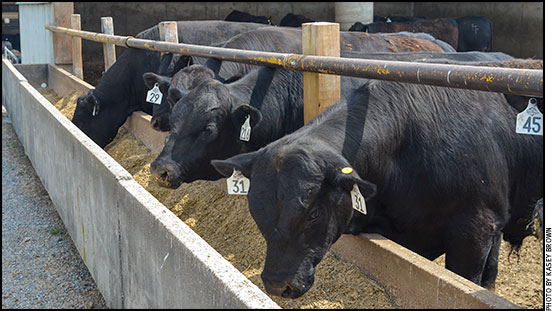HEALTH & NUTRITION...

Feed for Fertility
Preweaning feed for young bulls affects future fertility.
Young bulls must be adequately fed for proper growth and development and future fertility, but we are still learning about the best ways to feed for optimum fertility.
John Kastelic, veterinarian and professor of cattle reproductive health at the University of Calgary, has done many studies on nutrition in bulls. He says breeders need to understand the importance of the preweaning phase of the young bull’s life. Read more.
Review Animal Health Challenge Areas to Assess Feed Hygiene
Dairy and beef producers should first identify poor feed hygiene contributors in order to best combat their effects.
As new and different farm management schemes are adopted and new ensiling technology continues to emerge to improve feed fermentation across all sectors of the agriculture industry, the opportunities for improved feed hygiene also grow. The term “feed hygiene” refers to the anti-nutritional factors that affect the purity and sanitation of feeds — from the field, to fermentation and through feeding. Even while knowledge in the sector of anti-nutritional factors continues to grow and management factors that contribute to poor feed hygiene are identified, an easy solution to combat all of these aspects remains unfound. Read more.
Three to Watch
Herd Security/BVD Working Group addresses bovine health concerns.
It’s no secret that, for the U.S. cattle industry, bovine viral diarrhea (BVD) is a major disease problem. Lesser-known, bovine leukemia virus (BLV) might be a more significant problem than we think, and there is little doubt that foot-and-mouth disease (FMD) could be disastrous for multiple livestock industries if it were reintroduced to the United States.
Research projects designed to provide better understanding of these three infectious diseases were the topics addressed by scientists making presentations to the National Cattlemen’s Beef Association (NCBA) Herd Security/BVD Working Group, which met during the 2018 Cattle Industry Convention in Phoenix, Ariz. Read more.

Justin Sexten
Early path to quality beef.
You know the role health and nutrition play in feedlot performance, carcass quality grade and profitability. Yet many readers challenge the idea that these benefits can be realized at the ranch, unless they retain ownership beyond the farm or ranch gate.
The increasingly transparent market with buyers tracking results by source underscores that producing high-quality beef takes a systematic approach no one segment can afford to ignore. Ever. The time required to influence your herd’s genetic potential is measured in years, so managing for quality is always important.
Read more.
The Lasting Benefits of Preweaning Vaccinations in Beef Calves
Early vaccination of calves can help improve the health of your cattle herd.
“Producers should consider vaccinating calves at 2 months to 4 months of age, depending on the operation,” said DL Step, professional services veterinarian, Boehringer Ingelheim.
Colostrum consumed by a newborn calf provides protection against infectious diseases. However, this protection is only temporary, lasting a few weeks to months, and calves must start building their own immunities1. Vaccination during this time of transition can help protect the calf until weaning age. The following are three key benefits of incorporating preweaning vaccinations on your operation. Read more.
Better Test Than Guess
Utah veterinary toxicologist reports finding mineral deficiencies in herds across the country.
Beef cows, especially the “easy keepers,” seem to make a living on a wide mix of forages across the country and for most of the year. Trouble in the form of mineral and vitamin deficiencies could lurk below that outward appearance, costing hundreds of dollars in production losses.
That’s according to Jeffery Hall of Utah’s State Diagnostic Lab, in remarks at this year’s Cattle Industry Convention in Phoenix, Ariz. The leading concerns nationwide — copper and selenium deficiencies — can cause white-muscle disease and weaken immune function to let in pneumonia, diarrhea and other diseases. Other potential shortages may relate to zinc, manganese or vitamins A and E. Read more.
Biosecurity Recap
Livestock owners encouraged to review regulations before moving animals this spring.
Spring and summer exhibitions, like county fairs, are right around the corner. The Minnesota Board of Animal Health reminds livestock owners to review animal health and movement regulations before hitting the road. Moving livestock can be a burdensome process, which can go much more smoothly when everyone prepares ahead of time.
Regulations at exhibitions for official identification and health documentation for animals moving between states are in place to protect the health of the animals and the livelihood of livestock businesses and enthusiasts.
Before you even begin getting ready to move your animal, make sure it’s healthy by scheduling an appointment with your veterinarian. If you’re moving your animal interstate, you must have your veterinarian examine the animal and write a Certificate of Veterinary Inspection. Read more.
Cattle Diseases: Common Conditions/Terms
Click here for a list of common conditions and terms related to beef cattle diseases, such as anaplasmosis, brucellosis, BVD, E. coli, IBR and others.
[Click here to go to the top of the page.]







